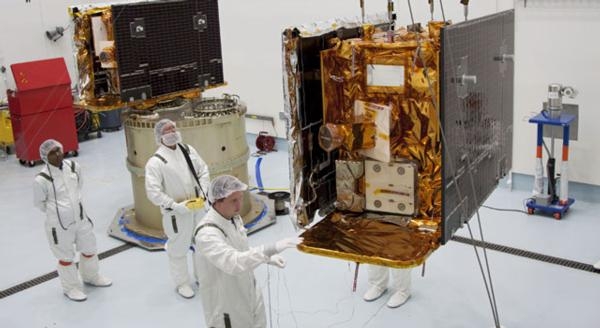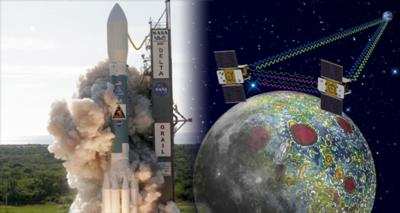Sun, Jan 01, 2012
First of NASA's GRAIL Spacecraft Starts Orbit
NASA has confirmed that the first of two NASA spacecraft to
study the moon in unprecedented detail has entered lunar orbit.
NASA's Gravity Recovery And Interior Laboratory (GRAIL)-A
spacecraft successfully completed its planned main engine burn at 2
p.m. PST (5 p.m. EST) today. As of 3 p.m. PST (6 p.m. EST), GRAIL-A
is in an orbit of 56 miles by 5,197 miles around the moon that
takes approximately 11.5 hours to complete.

"My resolution for the new year is to unlock lunar mysteries and
understand how the moon, Earth and other rocky planets evolved,"
said Maria Zuber, GRAIL principal investigator at the Massachusetts
Institute of Technology in Cambridge. "Now, with GRAIL-A
successfully placed in orbit around the moon, we are one step
closer to achieving that goal."
The next mission milestone occurs tomorrow when GRAIL-A's mirror
twin, GRAIL-B, performs its own main engine burn to place it in
lunar orbit. At 3 p.m. PST (6 p.m. EST) today, GRAIL-B was 30,018
miles from the moon and closing at a rate of 896 mph. GRAIL-B's
insertion burn is scheduled to begin tomorrow, Jan. 1, at 2:05 p.m.
PST (5:05 p.m. EST) and will last about 39 minutes.
"With GRAIL-A in lunar orbit we are halfway home," said David
Lehman, GRAIL project manager at NASA's Jet Propulsion Laboratory
in Pasadena, Calif. "Tomorrow may be New Year's everywhere else,
but it's another work day around the moon and here at JPL for the
GRAIL team."

Once both spacecraft are confirmed in orbit and operating,
science work will begin in March. The spacecraft will transmit
radio signals precisely defining the distance between them as they
orbit the moon in formation. As they fly over areas of greater and
lesser gravity caused by both visible features, such as mountains
and craters, and masses hidden beneath the lunar surface, the
distance between the two spacecraft will change slightly.
Scientists will translate this information into a high-resolution
map of the moon's gravitational field. The data will allow
scientists to understand what goes on below the lunar surface. This
information will increase knowledge of how Earth and its rocky
neighbors in the inner solar system developed into the diverse
worlds we see today.
JPL manages the GRAIL mission for NASA's Science Mission
Directorate at the agency's headquarters in Washington. The GRAIL
mission is part of the Discovery Program managed at NASA's Marshall
Space Flight Center in Huntsville, Ala. Lockheed Martin Space
Systems in Denver built the spacecraft.
More News
Aero Linx: Transport Canada We are a federal institution, leading the Transport Canada portfolio and working with our partners. Transport Canada is responsible for transportation p>[...]
Gross Navigation Error (GNE) A lateral deviation from a cleared track, normally in excess of 25 Nautical Miles (NM). More stringent standards (for example, 10NM in some parts of th>[...]
From AirVenture 2017 (YouTube Edition): Flight-Proven Booster On Display At AirVenture… EAA AirVenture Oshkosh is known primarily as a celebration of experimental and amateu>[...]
Aircraft Parachute System (CAPS) Was Deployed About 293 Ft Above Ground Level, Which Was Too Low To Allow For Full Deployment Of The Parachute System Analysis: The day before the a>[...]
Also: 48th Annual Air Race Classic, Hot Air Balloon Fire, FAA v Banning 100LL, Complete Remote Pilot The news Piper PA-18 Super Cub owners have been waiting for has finally arrived>[...]
 ANN's Daily Aero-Linx (06.29.25)
ANN's Daily Aero-Linx (06.29.25) ANN's Daily Aero-Term (06.29.25): Gross Navigation Error (GNE)
ANN's Daily Aero-Term (06.29.25): Gross Navigation Error (GNE) Classic Aero-TV: Anticipating Futurespace - Blue Origin Visits Airventure 2017
Classic Aero-TV: Anticipating Futurespace - Blue Origin Visits Airventure 2017 NTSB Final Report: Cirrus SR22
NTSB Final Report: Cirrus SR22 Airborne Affordable Flyers 06.26.25: PA18 Upgrades, Delta Force, Rhinebeck
Airborne Affordable Flyers 06.26.25: PA18 Upgrades, Delta Force, Rhinebeck




